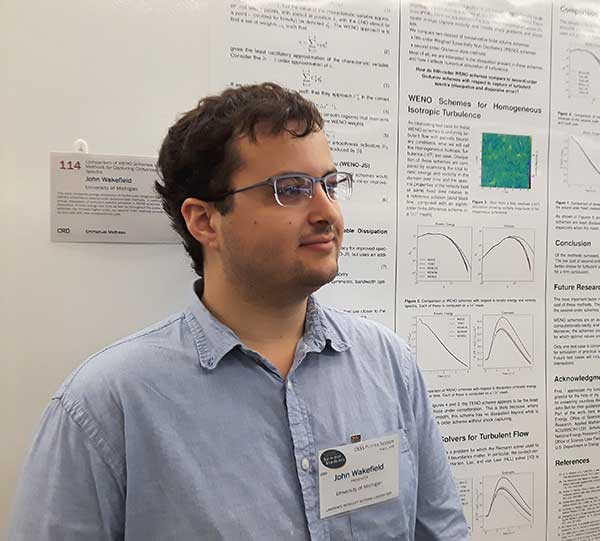Meet a Participant: John Wakefield

John Wakefield, a recent intern with the National Science Foundation’s (NSF) Mathematical Sciences Graduate Internship (MSGI) Program, attempted to solve the unsolvable—approximating solutions for partial differential equations which make computer models of the world around us possible.
Using mathematics to improve modeling of the world around us
John Wakefield has always enjoyed mathematics. Growing up, he took many courses in science, technology, engineering and mathematics (STEM).
“At some point, I realized I could actually pursue a career in these areas,” Wakefield said. He has followed that love of STEM throughout his academic and professional life. While pursuing a doctoral degree in applied and interdisciplinary mathematics at the University of Michigan, Wakefield interned with the National Science Foundation’s (NSF) Mathematical Sciences Graduate Internship (MSGI) Program.
The NSF MSGI program offers research opportunities for mathematical sciences doctoral students to participate in internships at national laboratories, industries and other facilities. NSF MSGI seeks to provide hands-on experience for the use of mathematics in a nonacademic setting.
For Wakefield, interning with NSF MSGI meant traveling to Lawrence Berkeley National Laboratory (LBNL), Berkeley, California, to perform research in numerical simulations.
The world around us can be modeled by mathematical equations that are solved numerically with computers, called numerical simulations. In STEM fields, numerical simulations are integral parts of research, advancement and decision making. In industry, numerical simulations are widely employed by engineers. These simulations provide detailed and crucial information during the early stages of design. For example, a gas turbine engine is a very sensitive system that has matured over many decades of development. Using simulations, engineers can evaluate in little time and at modest cost how the smallest change in the design of the engine can benefit the system or lead to a total failure. However, the accuracy of numerical simulations depends on their capability to integrate the significant complexity of the physics of the problem investigated.
Such complexity calls for the use of partial differential equations that are capable of modeling multidimensional systems. Some partial differential equations can be solved with pen and paper in simple academic cases; unfortunately, that’s not the same for a very complex configuration, such as an industrial gas turbine engine. Numerical methods must be utilized to approximate solutions for these partial differential equations, which is an entire field within itself.
“Many people are unaware that numerical analysis and simulation exist as a field. Many equations that govern physical phenomena can’t be explicitly solved, and there are a lot of unexpected difficulties that arise when attempting to approximate solutions to them,” Wakefield said.
At LBNL, Wakefield was stationed in the Center for Computational Sciences and Engineering group under the mentorship of Emmanuel Motheau, Ph.D. Wakefield evaluated numerical methods for approximating solutions to partial differential equations. In particular, Wakefield studied several numerical methods’ performance in simulating propagation of shock waves through turbulent flow. Much of Wakefield’s time was spent on the development of a chain of tools to quickly and easily perform the complex analysis of turbulent flow, a process that requires many steps. The main challenge was to design these tools to process large data sets on exascale supercomputers.
Wakefield enjoyed his introduction to research in an office environment and the interaction with other students and staff at the lab. “I learned a great deal and gained a lot of perspective on what research [in this area] is being done. The problem I was studying was interesting and presented countless possible future directions,” Wakefield said.
Wakefield’s research investigating methods to solve partial differential equations helps the development of better and more accurate models. These models increase our understanding of the world at large, as well as the design and improvement of technologies that enhance the quality of life.
“I enjoyed and learned a lot from the experience. The program presents a challenge and helps students with whatever skills they are missing, making it an excellent learning opportunity,” Wakefield said. “Whichever career I find myself in in the future, I hope it allows me to work on interesting problems like the ones I did this summer.” Wakefield has returned to the University of Michigan to continue his studies for a doctoral degree.
The NSF MSGI Program is funded by NSF and administered through the U.S. Department of Energy’s (DOE) Oak Ridge Institute for Science and Education (ORISE). ORISE is managed for DOE by ORAU.


